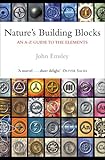Nature's building blocks : an A-Z guide to the elements / John Emsley.
Material type: TextPublication details: Oxford : Oxford University Press, 2003.Description: 538 p. ; 24 cmISBN:
TextPublication details: Oxford : Oxford University Press, 2003.Description: 538 p. ; 24 cmISBN: - 0198503407
- 9780198503408
- 546 21
- QD466 E52 2003
| Item type | Current library | Home library | Collection | Shelving location | Call number | Vol info | Copy number | Status | Date due | Barcode |
|---|---|---|---|---|---|---|---|---|---|---|
 Libro
Libro
|
Biblioteca Juan Bosch | Biblioteca Juan Bosch | Humanidades | Humanidades (4to. Piso) | QD466 E52 2003 (Browse shelf(Opens below)) | 3 | 1 | Available | 00000054404 |
Originally published: 2001.
What is the most common element in the universe? Can you name the noble gases? Everything we see around us is made of chemical elements, but most of us know little about them.Penned by award-winning science writer John Emsley, Nature's Building Blocks explains the what, why and wherefore of the chemical elements. Arranged alphabetically, from Actinium to Zirconium, it is a complete guide to all 115 of those that are currently known, with more extensive coverage of those elements we encounter in our everyday life. The entry on each element reveals where it came from, what role it may have in the human body, and the foods that contain it. There are also sections on its discovery, its part in human health or illness, the uses and misuses to which it is put, and its environmental role. Readers discover that the Earth consists of around 90 elements, some of which are abundant, such as the silicon and oxygen of rocks and soils, while some are so rare that they make gold seem cheap. Our own bodies contain about 30 elements, some in abundance, some in trace amounts; some vital to our health, and some that are positively harmful. A list of the main scientific data, and outline properties, are given for every element and each section ends with an "Element of Surprise," which highlights some unexpected way in which each element influences our everyday life.Both a reliable reference source and a high browsable account of the elements, Nature's Building Blocks offers a pleasurable tour of the very essence of our material world.
Preface -- Acknowledgements -- Introduction -- Elements (A-Z) -- Periodic table -- Appendix: Discovery of the elements in chronological order -- Bibliography -- Lists of elements and atomic numbers.


There are no comments on this title.